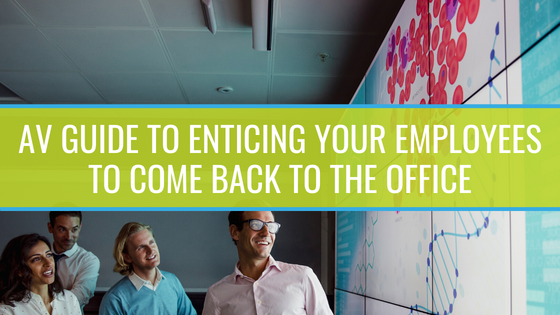[vc_row][vc_column][vc_column_text]The 2020 pandemic forever changed the way businesses organize their teams. Without offices to commute to, many professionals got used to doing everything virtually, including how they collaborate and how they run their meetings.
Now, managers want those remote employees to return to the workplace. According to Microsoft's Work Trend Index, more than 80 percent of business decision makers believe getting people back into the office is a major concern.
It's not going to be easy, though. The in-person to remote transition may have practically happened overnight, but many professionals aren't going back just because it’s in the best interest of the company. In fact, Microsoft's survey also found that 73 percent of professionals need more than a company mandate to give up their new-found work flexibility.
That's where AV solutions can help. Long before the pandemic struck, AV technology has facilitated better connections between teams, and that power can now be leveraged to make in-office work more engaging.
Remote Employees are Seeking Better Connections with Their Coworkers
Although companies are having difficulty in convincing their teams to return to the office, there are signs that some remote professionals might welcome it. About half of remote workers state that their relationships with close coworkers have suffered, and about half also state that they feel generally disconnected from the company.
Disconnected employees are less productive and less engaged, which offers the question: How can an organization improve the way its people connect with each other in the office?
The answer for some is better AV technology.
What AV Solutions Support Better, More Engaging In-person Work?
How can AV offer opportunities for a better in-office work experience? Here are some solutions that can make an impact:
- Interactive displays - Interactive displays already play a major role for hybrid and remote teams, but they're just as effective for in-person meetings. One of the factors motivating remote employees to stay remote is undoubtedly meeting quality. Traditional meetings are just not that engaging, with static presentation materials and one-sided conversations that have people staring down the clock.
Interactive displays change this dynamic. With an interactive display, in-office meetings can easily incorporate meaningful collaboration, no matter the subject. The Clevertouch, for example, makes it simple to launch a whiteboarding session in seconds and begin taking notes. During the meeting, the presenter (or anyone else) can use the board to bring in supporting materials from the internet and encourage visual brainstorming. Meetings are much more engaging when everyone is expected to participate, and the Clevertouch allows everyone, regardless of familiarity with the technology, to share content and make meaningful notes.
The Clevertouch can also be integrated into your organization's existing conferencing technology with ease, as it can work with Zoom Rooms, Microsoft Teams Rooms or with companies that prefer a BYOD approach.
- Wireless presentation technology - Wireless presentation solutions took hold during the pandemic because of the better cleanliness they support, but even as pandemic fears lessen, they are still effective tools for in-office collaboration.
And they're even better for hybrid teams, though. In a hybrid work setup, some professionals may only be in the office occasionally, so they may not be as familiar with any technology used in meeting rooms. That can be a major challenge for a meeting's presenter if they are rarely in the office.
Wireless presentation solutions like the Barco Clickshare and Mersive Solstice are a perfect answer to this challenge, as they make it simple for people to access the room's collaboration technology, even if they're never in the office.
Wireless presentation solutions make this possible because it only takes a few moments to connect to everything in the room - conferencing hardware, audio, lighting - everything. Connection is handled through on-screen prompts delivered by the room's displays. The meeting's presenter launches the appropriate app on their own device, enters a short-lived passcode, and that's it. Once connected, the presenter can control everything from their own device and even share content to the room's display. All this without touching a single piece of hardware in the room.
If your organization anticipates an adjustment period as people return to the office, wireless presentation solutions can provide a BYOD bridge that ensures people aren't intimidated by in-office collaboration technology.
- Improved training room technology - One way to incentivize a remote workforce is to offer more effective training to those onsite. Young professionals, in particular, are open to improving their skills through advanced training, and that training is hard to deliver through remote means only.
AV solutions can greatly improve your company's training space or spaces. Large digital displays, interactive displays, enhanced audio solutions, document cameras, augmented reality (AR) and virtual reality (VR) solutions can all be integrated to produce an unmatched training experience.
And improved training is the ultimate win-win for companies. Invest in better training methods and you'll not only be more likely to bring people back to the office - you'll also be more likely to retain those employees as they enhance their skills and capabilities for the company.[/vc_column_text][/vc_column][/vc_row]



